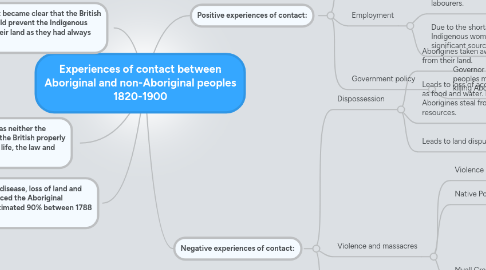
1. Conflict arose when it became clear that the British were staying and would prevent the Indigenous peoples from using their land as they had always done.
2. Tension built gradually, as neither the Indigenous peoples nor the British properly understood the ways of life, the law and traditions of the other.
3. The combination of disease, loss of land and direct violence reduced the Aboriginal population by an estimated 90% between 1788 and 1900.
4. Positive experiences of contact:
4.1. Cooperation
4.1.1. During the early days of the colonisation, many Aboriginal people and settlers often lived quite closely together without too much conflict.
4.2. Employment
4.2.1. Many Indigenous people adapted to European culture, working as stock hands or labourers.
4.2.2. Due to the shortage of labor during the gold rush, Indigenous women, men and children became a significant source of labour.
4.2.2.1. Most Indigenous labour was unpaid. Most were paid in the form of food, clothing and other basic necessities.
4.3. Government policy
4.3.1. Governor Phillip ordered that the Aboriginal peoples must be well-treated, and that anyone killing Aboriginal people would be hanged.
5. Negative experiences of contact:
5.1. Dispossession
5.1.1. Aborigines taken away or forced from their land.
5.1.2. Leads to loss of access to sacred sites and resources such as food and water. Due to scarcity of resources, some Aborigines steal from white settlers or sabotage their resources.
5.1.2.1. Cycle of revenge begins.
5.1.3. Leads to land disputes.
5.1.3.1. Mabo Case 1992 sought to deal with Aboriginal land ownership.
5.1.3.1.1. Native Title Act 1993.
5.2. Violence and massacres
5.2.1. Violence is a result of dispossession.
5.2.2. Native Police recruited.
5.2.3. Myall Creek Massacre, 1838.
5.2.3.1. The murder of 28 unarmed Aborigines (men, women and children) by armed white stockmen.
5.2.3.2. Seven of the perpetrators were charged with murder and were hanged. the first time that white settlers had been executed for the murder of Aboriginal people in Australia.
5.2.3.3. Highlighted the issue of lawlessness in regional areas.
5.3. Government control
5.3.1. Protection era 1855-1937.
5.3.2. Protection policy: removing full-blood Aborigines from their communities and placing them on reserves or in missions.
5.3.2.1. This remains a social issue today.
5.3.2.2. Aboriginal children removed from their families named "The Stolen Generation".
5.3.2.3. Aboriginal reconciliation: Kevin Rudd's apology and Sorry Day.
